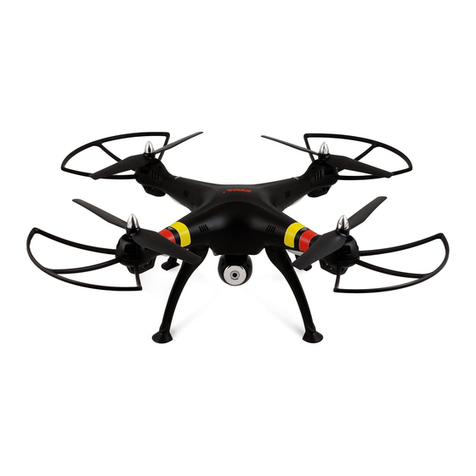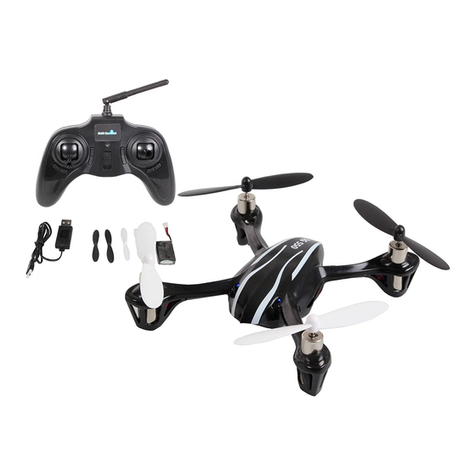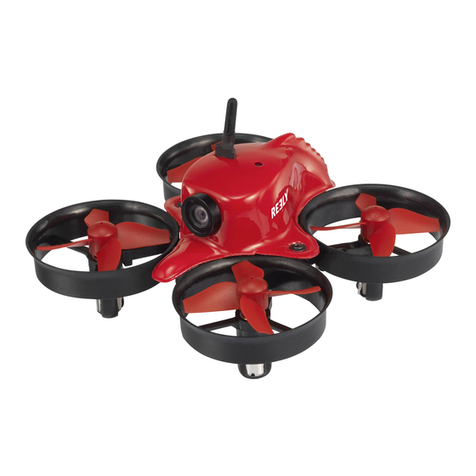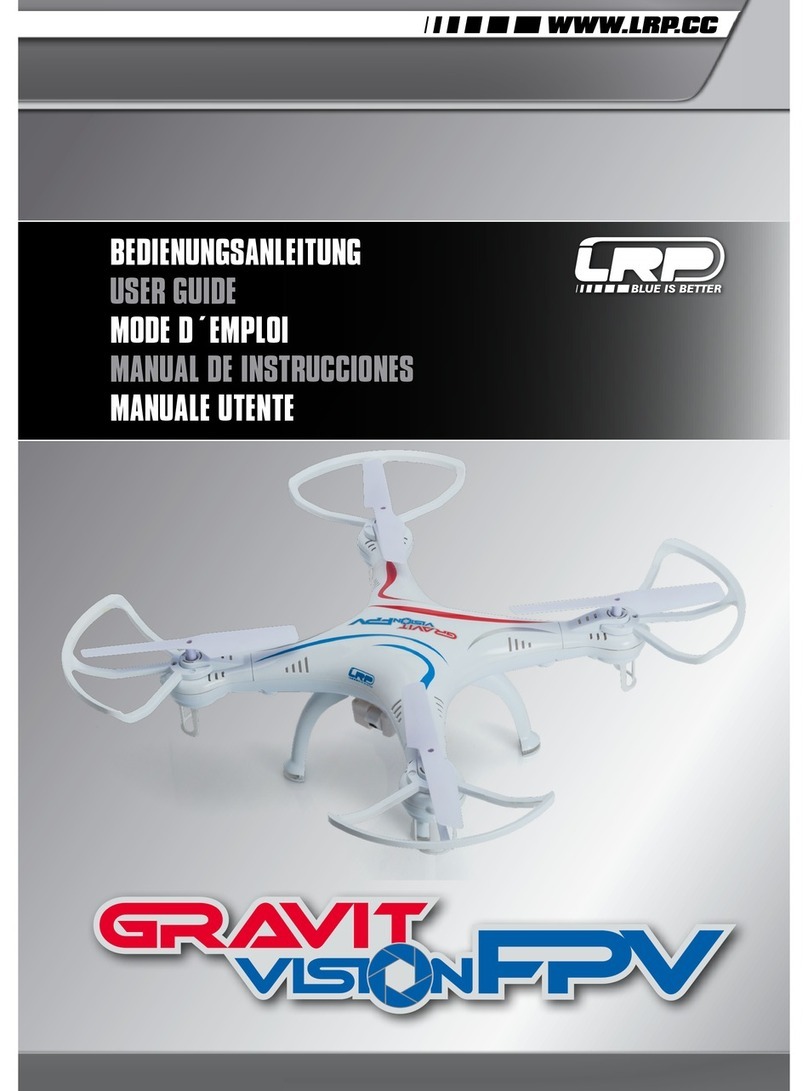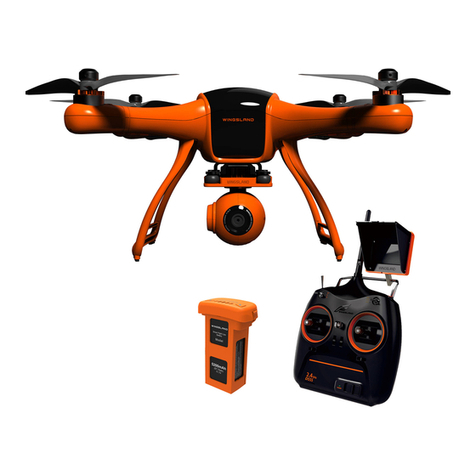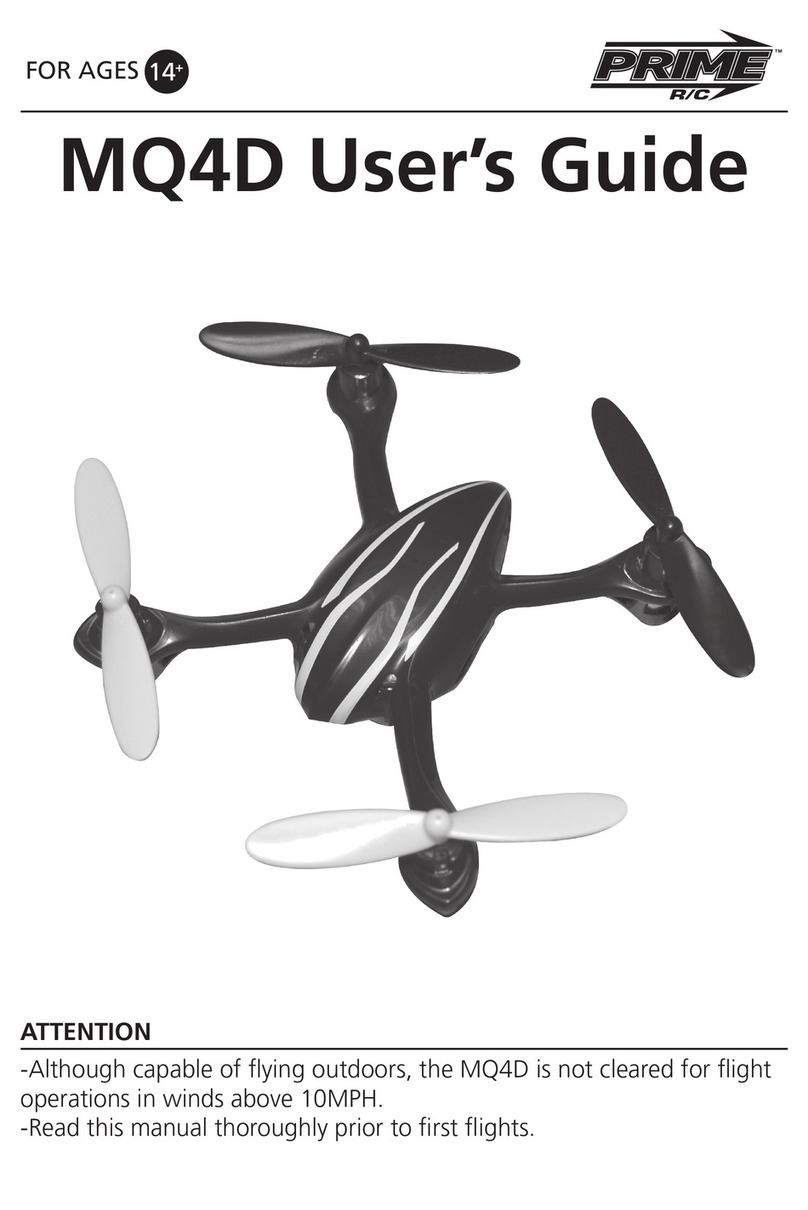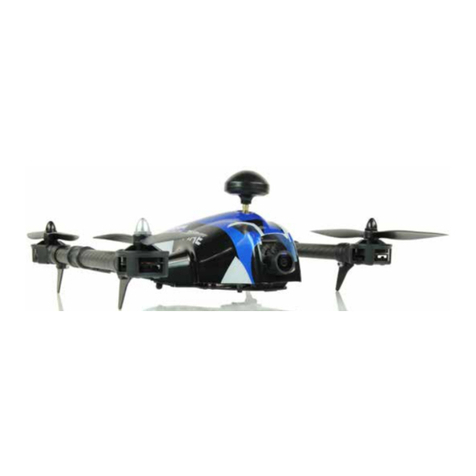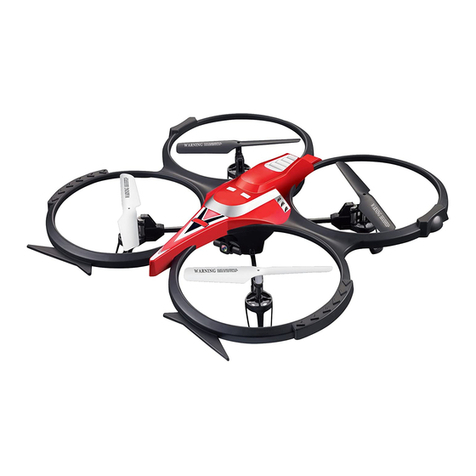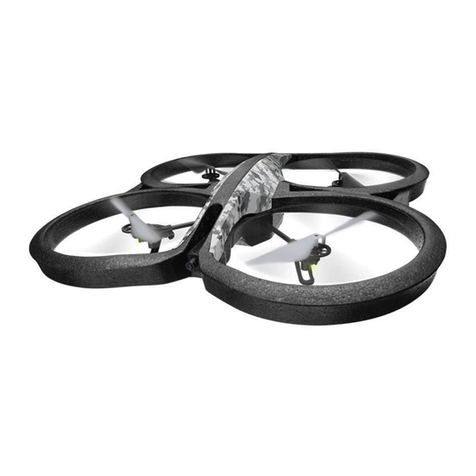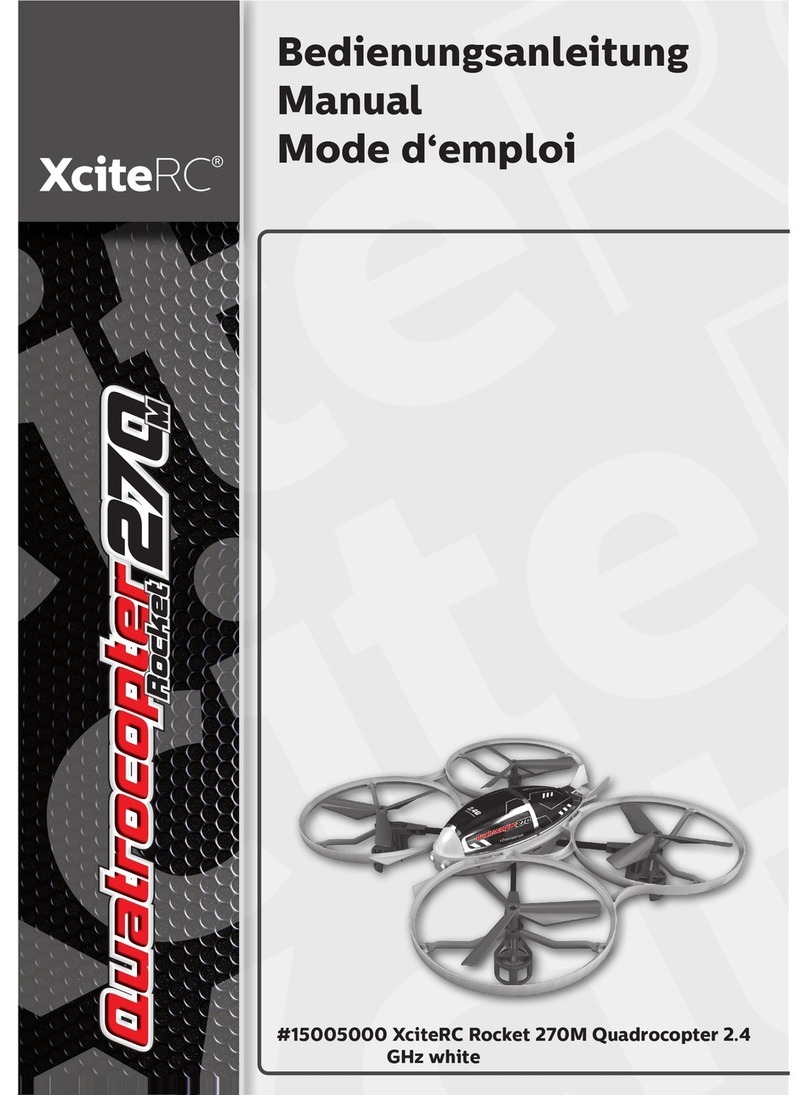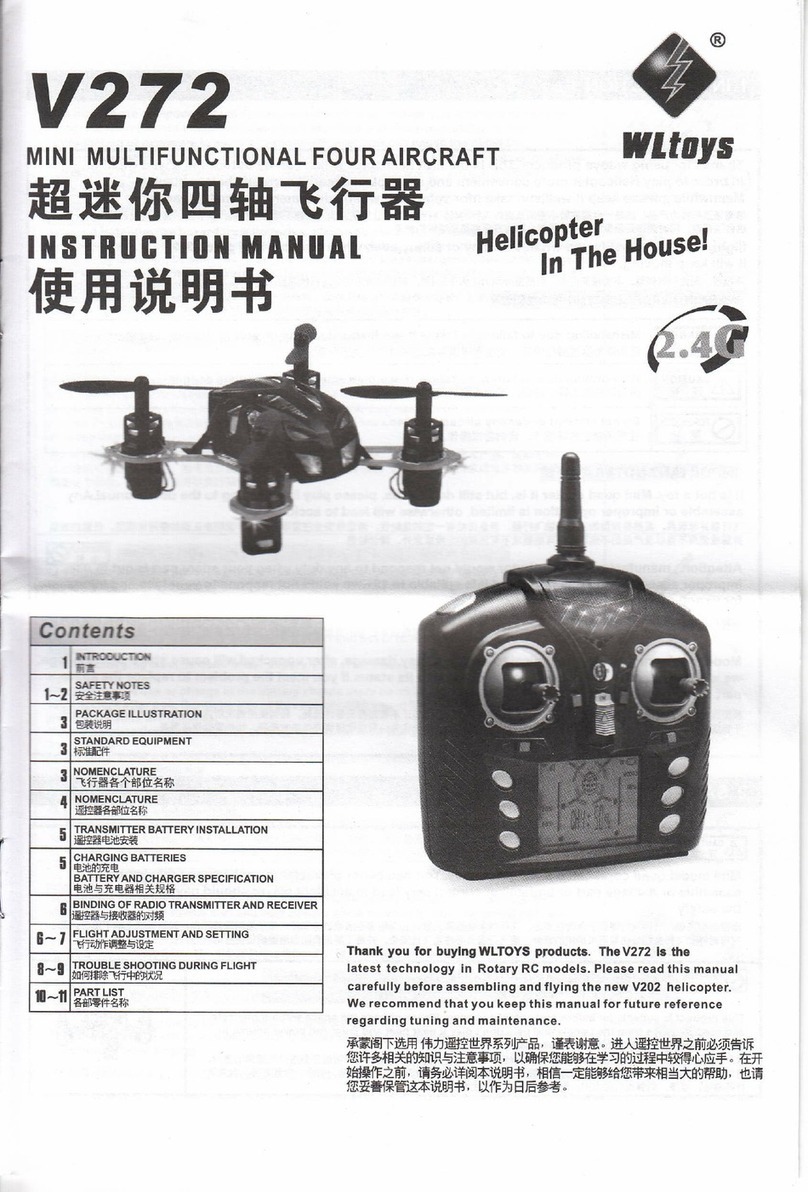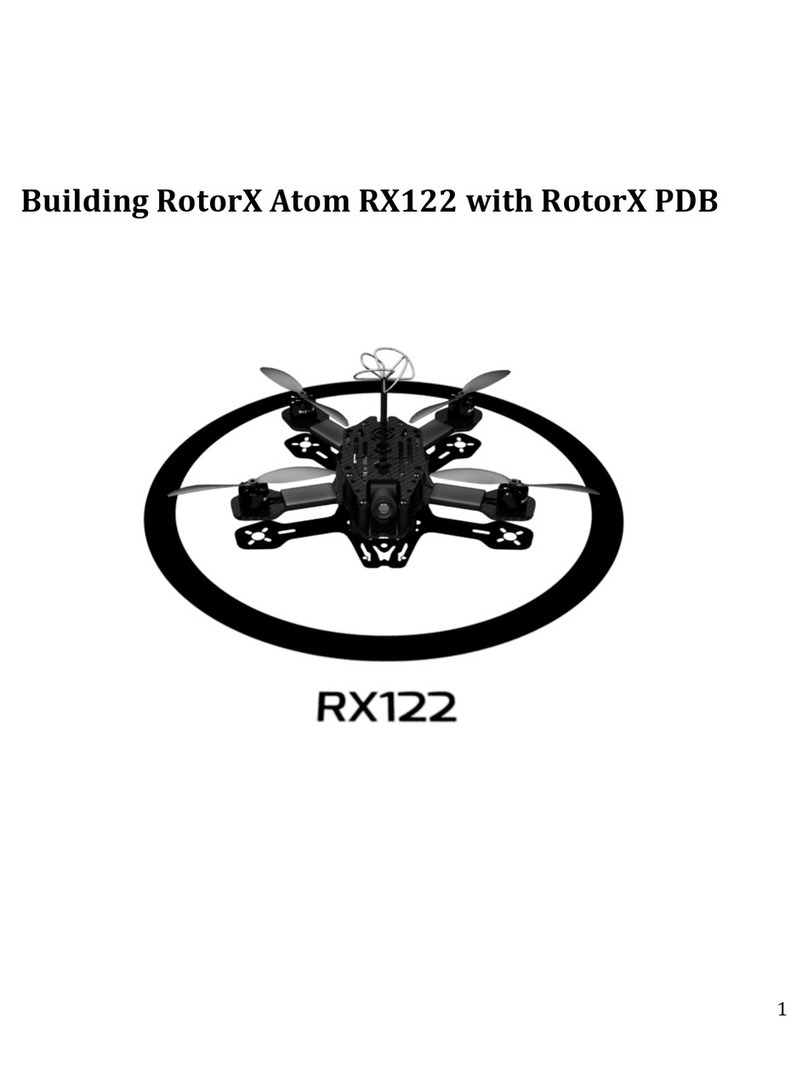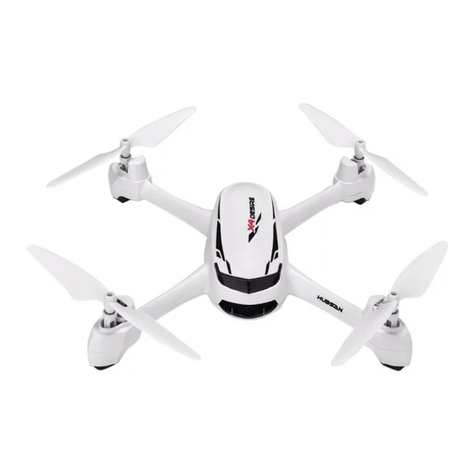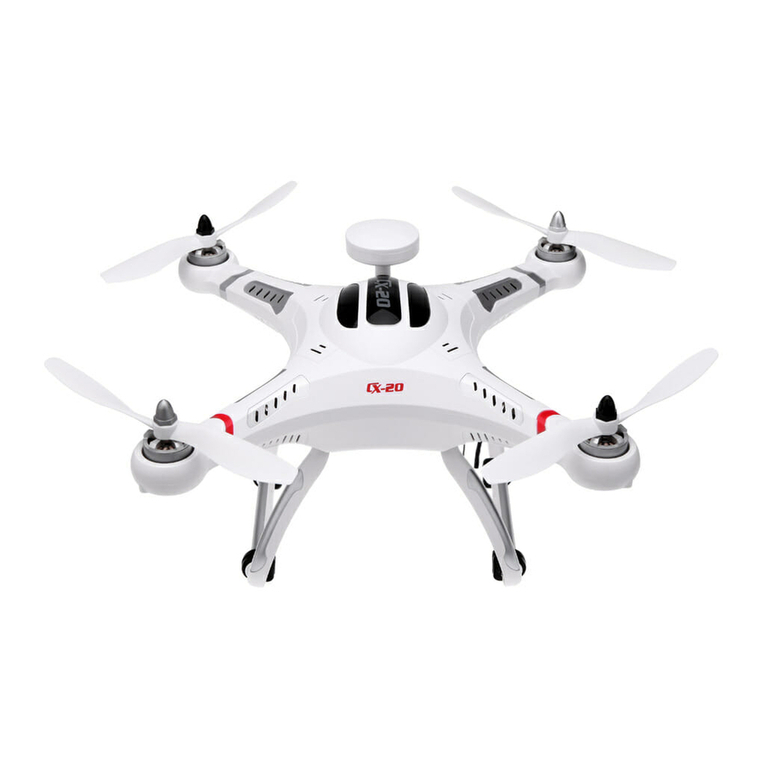Hama Crabro User manual

PL
F
D
GB
RO
Operating Instructions
Bedienungsanleitung
Mode d‘emploi
Instrukcja obsługi
Manual de utilizare
CrabroQuadrocopter
Quadrocopter
00
126850

9
3
5
4
1 8 7
2 6
3
4
1
5
6
27

6
GOperating instruction
Controls and displays
A: Model aircraft
1Rotors
2Fuselage
3Landing/standing legs
4LEDs
5Rotor guard
6Charging socket
7Slide switch for ON/OFF
B: Remote control
1Speed controller
2Left control lever
3ON/OFF slide switch
4Tweaking (trimming),
forwards/backwards
5Tweaking (trimming), left/right
6Right control lever
7Loop/Reset
8LED indicator
9Battery compartment
Thank you for choosing a Hama product.
Take your time and read the following instructions and
information completely. Please keep these instructions in a
safe place for future reference. If you sell the device, please
pass these operating instructions on to the new owner.
1. Explanation of Warning Symbols and Notes
Warning
This symbol is used to indicate safety instructions or to
draw your attention to specic hazards and risks.
Note
This symbol is used to indicate additional information or
important notes.
2. Package contents
•1 x remote control
•1 x USB charging cable
•4 x replacement rotor blades
•2 x AA batteries
•These operating instructions
3. Safety instructions
•Protect the product from dirt, moisture and overheating,
and only use it in a dry environment.
•Do not drop the product and do not expose it to any
major shocks.
•Do not operate the product outside the power limits
given in the specications.
•Make sure that you y the drone in such a manner that
you always have the product under control, and do not
overestimate your capabilities.
•Keep hair, face, hands and loose clothing away from the
product during operation. The rotors pose a risk of injury,
as does the moving product in general.
•Keep the packaging material out of the reach of children
due to the risk of suffocation..
•Do not modify the product in any way. Doing so voids
the warranty.
Warning - Batteries/ Accus
•Only use batteries (or rechargeable batteries) that
match the specied type.
•Do not mix old and new batteries or batteries of a
different type or make.
•When inserting batteries, note the correct polarity (+
and - markings) and insert the batteries accordingly.
Failure to do so could result in the batteries leaking or
exploding.
•Do not overcharge batteries.
•Keep batteries out of the reach of children.
•Do not short circuit the batteries/rechargeable
batteries and keep them away from uncoated metal
objects.
•Immediately remove and dispose of dead batteries
from the product.

7
4. Legal regulations/limitations when operating
model aircraft
Note
•The information on legal regulations set out in these
instructions covers only the German regulations and
laws at the time of printing. Before using the product
in other countries, nd out about the applicable
regulations!
•Please note that in accordance with §1, para. 2, no.
9 of the German Air Trac Act (Luftverkehrsgesetz or
LuftVG), a model aircraft is considered to be aircraft,
and in accordance with §43 LuftVG, liability insurance
is needed. Find out from your insurance provider
whether your personal liability insurance already
covers the control of a model aircraft.
•A licence may be required for commercial use. Contact
your local authorities (for example, public order oce) to
clarify the legal issues.
•If you take photos or videos with this product, their use
is considered commercial if they are published on the
Internet, for example, and you allow any associated
advertising!
5. Operating environment and proper use
•This product is intended for use only in sporting and
leisure activities.
•This product is intended for use by children aged 8 or
older under parental supervision.
•If using the product indoors, the room should be of
adequate size.
•There is a general prohibition on climbing and operating
model aircraft:
•Over gatherings of people
•Over accident sites and disaster areas
•Over operation sites of state bodies (for example,
police, authorities) and organisations with security
responsibilities
•Over penal institutions
•Over industrial and energy generation plants
(including solar parks)
•Over military facilities and restricted areas
•Over and near airelds/airports
•Over and near hospitals
•Over federal highways, federal waterways and
railway facilities
•Over conservation areas
•Over stadiums
•Over amusement parks
•Note that special, extended regulations and prohibitions
on climbing model aircraft apply in large cities such as
Berlin, Hamburg, Cologne, etc.
•Respect the personal and property rights of others! Do
not use camera drones to capture images of other people
without rst asking for their permission.
•Do not y over third-party property!
•Do not y near people, waters, radio masts or power
lines, and do not frighten animals with the product!
•In areas where you are allowed to operate and climb
a model aircraft, observe a maximum ying altitude of
100 m.
•In areas where you are allowed to operate and climb a
model aircraft, only y within the range of vision.
•In general, the following applies: Do not disturb your
fellow human beings and your environment through
actions that go against general decorum and/or that you
yourself would consider to be a nuisance.
•The pilot in command of the drone is, in principle, liable
for all damages that may be caused during a ight.
•Keep an eye on the battery of the drone. Land
immediately if the battery loses power, so as not to
crash.
•Before ying, make sure the weather conditions are
suitable.
•Always anticipate hazards when ying! Pay attention to
both the drone and your environment.
•Do not use any technical devices to extend the range of
vision.
•Unmanned aviation systems and model aircraft are
obliged to give way to manned aircraft and manned
balloons.
6. Getting started
Note
•Before using the product for the rst time, read these
operating instructions together with your child.
•Before getting started, familiarise yourself with the
product and its operation, ideally under the guidance
of a person who is experienced with similar products.
•The packaging can be used to store the product; it
protects the product from dust and damage.
6.1 Remote control – inserting the batteries
•Open the battery compartment (13) and insert four
AA batteries, observing correct polarity. Then close the
battery compartment cover.

8
6.2 Model aircraft – charging the battery
Note
•The battery, drone and charging adapter included in
the delivery go together and should always be used in
combination.
•Fully charge the battery of the drone before using it for
the rst time.
•Connect the supplied USB charging cable to the drone’s
charging socket (6).
•Connect the unused plug on the USB cable to an
available USB port on your computer or another suitable
USB charger. Please refer to the operating instructions for
the USB charger used.
•The LED indicator of the USB charging plug is lit red
during charging. When the battery is fully charged, the
LED indicator goes out.
Warning – rechargeable battery
•Only use suitable charging devices with USB
connections for charging.
•As a rule, do not use charging devices or USB
connections that are defective and do not try to repair
them yourself.
•Do not overcharge the product or allow the battery to
completely discharge.
•Avoid storing, charging or using batteries in extreme
temperatures.
•When stored over a long period of time, batteries
should be charged regularly (at least every three
months).
•After every ight and before charging, allow the
motors and the battery to completely cool!
•Continually monitor charging!
•Stop charging immediately if the battery becomes hot
and/or deformed!
•Use a heat-resistant, re-proof surface for charging!
Note – charging/battery capacity
•It takes approximately 30 minutes to fully charge the
battery.
•The battery comes partially charged. Initial charging
may therefore take less time.
•After a charging time of 30 minutes, the ying time is
approximately 6-8 minutes.
•The actual ying time varies according to use of the
product, the settings and ambient conditions (for
example, temperatures below 5°C and above 25°C
reduce battery capacity).
7. Flight mode
7.1 Pairing the drone with the remote control
•Place the drone on a level surface.
•Move the slide switch (7) on the drone to the ON
position. The LEDs (4) begin to ash.
•Move the slide switch on the remote control (3) to the
ON position.
•Move the left control lever (2) all the way up.
•Then move the left control lever (2) all the way down.
•A signal tone is emitted to conrm the pairing.

9
7.2 Flight control
Note
•Control the drone only with minimal movements
of the control levers so as to ensure smooth ight
behaviour.
•Avoid jerky movements. The drone could get out of
control.
Taking off and climbing
Left control
•To launch your drone or to gain altitude, move the left
control lever (2) on the remote control upwards.
Landing and descending
Left control
•To land the drone or to descend to a lower altitude,
move the left control lever (2) on the remote control
downwards.
Flying left and right
Right control
•To y the drone left, move the right control lever (9)
on the remote control to the left.
Right control
•To y the drone right, move the right control lever (9)
on the remote control to the right.
Flying forwards and backwards
Right control
•To y the drone forwards, move the right control lever
(9) on the remote control upwards.
Right control
•To y the drone backwards, move the right control
lever (9) on the remote control downwards.
Turning left or right
Left control
•To turn the drone left, move the left control lever (2)
on the remote control to the left.
Left control
•To turn the drone right, move the left control lever (2)
on the remote control to the right.
Loops – only for experienced pilots!
Note – Loops and 360° rolls
•The battery of the drone must be fully charged to be
able to use the loop function.
Right control

10
•Fly the drone at an altitude of approximately 3 m.
•Press and hold the Loop button (7).
•Move the right control lever (6) upwards or
downwards to perform a loop.
•Move the right control lever (6) to the left or right to
perform a 360° roll sideways.
7.3 Tweaking the control (trimming)
Note – Trimming
•The drone should be smooth and stable in the air,
and should y only in the direction that is set using
the control.
•After a certain time, there may be slight directional
tilts even though the control levers are in the resting/
neutral position.
•These directional tilts can be eliminated by trimming
the control.
Left/right
•If the drone continually tilts to the right during the ight,
briey push the Tweaking button (11) to the left. Repeat
this step until the drone is aligned.
•If the drone continually tilts to the left during the ight,
briey push the Tweaking button (11) to the right.
Repeat this step until the drone is aligned.
Forwards/backwards
•If the drone continually tilts forwards during the ight,
briey push the Tweaking button (10) downwards.
Repeat this step until the drone is aligned.
•If the drone continually tilts backwards during the ight,
briey push the Tweaking button (10) upwards. Repeat
this step until the drone is aligned.
7.4 Resetting the drone
Note
•Frequent/incorrect trimming can result in
misalignment of the drone.
•This can be eliminated by resetting the control to the
neutral position.
•Position the drone on a at horizontal surface.
•If necessary, pair the drone with the remote control. (See
Section 7.1)
•Press and hold the Loop button (7) until the LEDs of the
drone (4) begin to ash.
•The LEDs stop ashing once the drone has been
successfully reset.
7.5 Speed levels
Note
•Three speed levels (low, medium, high) can be
selected.
•When you switch on the product, the drone is set to
the low speed level.
•Experienced pilots can increase the drone’s speed by
selecting the medium or high speed level.
•Press the speed controller (1) to change the speed level.
7.6 Switching off the drone
•Land the drone.
•Move the left control lever (2) all the way down and hold
it there.
•Move the slide switch (7) on the drone to the OFF
position.
•Move the slide switch on the remote control (3) to the
OFF position.
8. Changing the rotor blades
•Remove the existing rotor blade by gently pulling it off
from the motor shaft.
•Lightly press the new rotor blade on the motor shaft.
•Make sure that the rotor blades are positioned correctly,
as otherwise the rotation direction will not be correct
and no drive is generated.
•The drone’s charging socket (6) marks the rear part of
the drone.
B2
A1
A2
B1

11
10. Troubleshooting
Problem Possible cause Solution
The drone stops for no apparent
reason and/or does not launch.
The battery of the drone is weak or
empty.
Fully charge the battery of the
drone.
The batteries of the remote control
are weak or empty.
Check the batteries of the remote
control and replace them with new
batteries if necessary.
The rotors of the drone do not move.
The battery of the drone is weak or
empty.
Fully charge the battery of the
drone.
The batteries of the remote control
are weak or empty.
Check the batteries of the remote
control and replace them with new
batteries if necessary.
Pairing of the drone with the remote
control has failed.
Switch off the drone and the remote
control, and then switch them back
on again.
Try pairing the drone and the remote
control again, as described in
Section 7.1 Pairing the drone with
the remote control.
The drone rotates only around its
vertical axis, overturns or does not
launch.
The propellers of the drone are
damaged or incorrectly arranged.
Check the propellers. Check the
arrangement of the propellers and, if
necessary, attach them as described
in Section 8 Changing the rotor
blades.
The drone pulls strongly in a
particular direction. The drone is not properly aligned.
Carry out tweaking as described in
Section 7.3 Tweaking the control
(trimming).
The drone won’t perform loops. The battery charge is too low. Fully charge the battery of the
drone.

12
11. Care and Maintenance
•Only clean this product with a slightly damp, lint-free
cloth and do not use aggressive cleaning agents.
•Make sure that water does not get into the product.
12. Warranty Disclaimer
Hama GmbH & Co KG assumes no liability and provides no
warranty for damage resulting from improper installation/
mounting, improper use of the product or from failure to
observe the operating instructions and/or safety notes.
13. Service and Support
Please contact Hama Product Consulting if you have any
questions about this product.
Hotline: +49 9091 502-115 (German/English)
Further support information can be found here:
www.hama.com
14. Technical specifications
Max. range: 30 m
Number of channels 4
Lighting Multi-coloured LED
Camera -
With (diagonal, without
propellers) 95 mm
Width x depth x height 80 x 80 x 20 mm
Weight 15 g
Rotor diameter 35 mm
Battery requirement for
drone
1 x lithium polymer
battery, 120 mAh
Battery requirement for
remote control 2 x AA battery
Type of charging USB-A connection
Frequency range 2.4 GHz
15. Recycling Information
Note on environmental protection:
After the implementation of the European Directive
2012/19/EU and 2006/66/EU in the national legal
system, the following applies: Electric and
electronic devices as well as batteries must not be
disposed of with household waste. Consumers are obliged
by law to return electrical and electronic devices as well as
batteries at the end of their service lives to the public
collecting points set up for this purpose or point of sale.
Details to this are dened by the national law of the
respective country. This symbol on the product, the
instruction manual or the package indicates that a product
is subject to these regulations. By recycling, reusing the
materials or other forms of utilising old devices/batteries,
you are making an important contribution to protecting
our environment.
16. Declaration of Conformity
Hereby, Hama GmbH & Co KG declares that the
radio equipment type [00126850] is in compliance
with Directive 2014/53/EU. The full text of the EU
declaration of conformity is available at the following
internet address:
www.hama.com->00126850->Downloads.
Frequency band(s) 2.446-2.477 GHz
Maximum radio-frequency
power transmitted 0.652 mW EIRP

2
DBedienungsanleitung
Bedienungselemente und Anzeigen
A: Flugmodell
1Rotoren
2Rumpf
3Lande-/Standbeine
4Akkuschacht
5Rotorschutz
6Ladebuchse
7Schieberschalter für ON/OFF
B: Fernsteuerung
1Geschwindigkeitsregler
2Linker Steuerhebel
3Schiebeschalter ON/OFF
4Feinjustierung (Trimmung) vorwärts/
rückwärts
5Feinjustierung (Trimmung) links/rechts
6rechter Steuerhebel
7Looping/Zurücksetzen
8LED-Anzeige
9Batteriefach
Vielen Dank, dass Sie sich für ein Hama Produkt
entschieden haben! Nehmen Sie sich Zeit und lesen Sie
die folgenden Anweisungen und Hinweise zunächst
ganz durch. Bewahren Sie diese Bedienungsanleitung
anschließend an einem sicheren Ort auf, um bei Bedarf
darin nachschlagen zu können. Sollten Sie das Gerät
veräußern, geben Sie diese Bedienungsanleitung an den
neuen Eigentümer weiter.
1. Erklärung von Warnsymbolen und Hinweisen
Warnung
Wird verwendet, um Sicherheitshinweise zu
kennzeichnen oder um Aufmerksamkeit auf besondere
Gefahren und Risiken zu lenken.
Hinweis
Wird verwendet, um zusätzlich Informationen oder
wichtige Hinweise zu kennzeichnen.
2. Packungsinhalt
•Drohne
•1x Fernsteuerung
•1x USB-Ladekabel
•4x Ersatz-Rotorblätter
•2x AA-Batterien
•diese Bedienungsanleitung
3. Sicherheitshinweise
•Schützen Sie das Produkt vor Schmutz, Feuchtigkeit und
Überhitzung und verwenden Sie es nur in trockenen
Räumen.
•Lassen Sie das Produkt nicht fallen und setzen Sie es
keinen heftigen Erschütterungen aus.
•Betreiben Sie das Produkt nicht außerhalb seiner in den
technischen Daten angegebenen Leistungsgrenzen.
•Achten Sie darauf, stets nur so zu iegen, dass Sie das
Produkt immer unter Kontrolle haben und überschätzen
Sie nicht Ihre Fähigkeiten.
•Halten Sie Haare, Gesicht, Hände und lose Kleidung
im Betrieb von dem Produkt fern. Es besteht
Verletzungsgefahr durch die Rotoren und/oder generell
durch das sich bewegende Produkt.
•Halten Sie Kinder unbedingt von dem
Verpackungsmaterial fern, es besteht Erstickungsgefahr.
•Nehmen Sie keine Veränderungen am Produkt vor.
Dadurch verlieren sie jegliche Gewährleistungsansprüche.
Warnung - Batterien/ Akkus
•Verwenden Sie ausschließlich Akkus (oder Batterien),
die dem angegebenen Typ entsprechen.
•Mischen Sie alte und neue Batterien nicht, sowie
Batterien unterschiedlichen Typs oder Herstellers.
•Beachten Sie unbedingt die korrekte Polarität
(Beschriftung + und -) der Batterien und legen Sie
diese entsprechend ein. Bei Nichtbeachtung besteht
die Gefahr des Auslaufens oder einer Explosion der
Batterien.
•Laden Sie Batterien nicht.
•Bewahren Sie Batterien außerhalb der Reichweite von
Kindern auf.
•Schließen Sie Akkus/Batterien nicht kurz und halten
Sie sie von blanken Metallgegenständen fern.
•Entfernen und entsorgen Sie verbrauchte Batterien
unverzüglich aus dem Produkt.

3
4. Gesetzliche Regelungen/Einschränkungen beim
Betrieb von Flugmodellen
Hinweis
•Beachten Sie, dass Hinweise zu gesetzlichen
Regelungen in diesen Hinweisen nur die deutschen
Vorschriften und Gesetze zum Zeitpunkt der
Drucklegung abbilden. Informieren Sie sich in anderen
Staaten vor der Verwendung des Produktes über die
dort geltenden Regelungen!
•Beachten Sie, dass gem. Luftverkehrsgesetz (LuftVG)
§1, Abs.2, Nr.9, ein Flugmodell als Luftfahrzeug
angesehen wird und hierfür gem. LuftVG §43 eine
Haftpichtversicherung vorhanden sein muss.
Informieren Sie sich bei Ihrem Versicherungsanbieter,
ob ihre Privathaftpicht die Steuerung eines
Flugmodells bereits abdeckt.
•Eine gewerbliche Nutzung ist ggf. genehmigungs-
pichtig. Wenden Sie sich an die lokalen Behörden (z.B.
Ordnungsamt), um die rechtlichen Fragen zu klären.
•Beachten Sie, dass mit diesem Produkt aufgenommene
Fotos/Videos als gewerbliche Nutzung gelten, wenn diese
Aufnahmen z.B. im Internet veröffentlicht werden und Sie
Werbung zu den Fotos/Videos erlauben!
5. Betriebsumgebung und bestimmungsgemäße
Verwendung
•Dieses Produkt ist nur für die Verwendung in Sport und
Freizeit vorgesehen.
•Dieses Produkt ist für die Verwendung ab 8 Jahren und
unter elterlicher Aufsicht vorgesehen.
•Bei der Nutzung des Produktes in Innenräumen müssen
diese ausreichend groß sein.
•Ein generelles Aufstiegs- und Betriebsverbot besteht:
•Über Menschenansammlungen
•Über Unfall-/Unglücksorten und
Katastrophengebieten
•Über Einsatzorten von Organen des Staates
(z.B. Polizei, Behörden) und Organisationen mit
Sicherheitsaufgaben
•Über Justizvollzugsanstalten
•Über Industrie- und Energieerzeugungsanlagen (auch
Solarparks)
•Über militärischen Anlagen und Sperrgebieten
•Über und in der Nähe von Flugplätzen/-häfen
•Über und in der Nähe von Krankenhäusern
•Über Bundesfernstraßen, Bundeswasserstraßen und
Bahnanlagen
•Über Naturschutzgebieten
•Über Stadien
•Über Vergnügungsparks
•Beachten Sie, dass in großen Städten, wie z.B.
Berlin, Hamburg, Köln etc., besondere und erweiterte
Regelungen und Aufstiegsverbote gelten!
•Respektieren Sie die Persönlichkeits- und
Eigentumsrechte Anderer! Machen Sie mit Kamera-
Drohnen keine Aufnahmen anderer Personen, ohne diese
vorher um Erlaubnis zu fragen.
•Fliegen Sie nicht über fremde Grundstücke!
•Fliegen Sie nicht in der Nähe von Personen, Gewässern,
Funkmasten, Stromleitungen und erschrecken Sie keine
Tiere mit dem Produkt!
•Beachten Sie in Bereichen, in denen Betrieb und
Aufstieg erlaubt sind, eine Flughöhe von max. 100m.
•Beachten Sie in Bereichen, in denen Betrieb und
Aufstieg erlaubt sind, nur in Sichtweite zu iegen.
•Generell gilt: belästigen Sie ihre Mitmenschen und ihre
Umwelt nicht durch Handlungen, die den allgemeinen
Anstandsregeln widersprechen und/oder die Sie selbst als
Belästigung ansehen würden.
•Der Führer der Drohne haftet grundsätzlich für alle
Schäden, die bei einem Flug verursacht werden können.
•Behalten Sie den Akku der Drohne im Blick. Landen Sie
umgehend, wenn die Akkuleistung abnimmt, um nicht
abzustürzen.
•Achten Sie vor dem Flug auf passende
Wetterverhältnisse.
•Fliegen Sie immer vorausschauend! Achten Sie
gleichzeitig auf die Drohne und Ihre Umgebung.
•Verwenden Sie keine technischen Geräte, um die
Sichtweite zu verlängern.
•Unbemannte Luftfahrtsysteme und Flugmodelle sind
verpichtet, bemannten Luftfahrzeugen und bemannten
Ballonen auszuweichen.
6. Inbetriebnahme
Hinweis
•Vor der ersten Benutzung: lesen Sie diese
Bedienungsanleitung zusammen mit Ihrem Kind.
•Machen Sie sich vor der ersten Inbetriebnahme
mit dem Produkt und seiner Bedienung vertraut,
idealerweise unter Anleitung einer mit gleichartigen
Produkten erfahrenen Person.
•Bei Nichtbenutzung dient die Verpackung als
Aufbewahrung und schützt das Produkt vor Staub und
Beschädigung.
6.1 Fernsteuerung – Batterien einlegen
•Öffnen Sie das Batteriefach (13) und legen Sie
4 AA-Batterien polrichtig ein. Schließen Sie die
Batteriefachabdeckung anschließend.

4
6.2 Flugmodell – Akku aufladen
Hinweis
•Akku, Drohne und Ladeadapter sind aufeinander
abgestimmt und dürfen nur in der ausgelieferten
Kombination verwendet werden.
•Laden Sie vor dem ersten Gebrauch den Akku der Drohne
einmal vollständig auf.
•Schließen Sie das mitgelieferte USB-Ladekabel an der
Ladebuchse (6) der Drohne an.
•Schließen Sie den freien Stecker des USB-Kabels an einer
freien USB-Buchse Ihres Computers oder einem anderen
geeigneten USB-Ladegerät an. Beachten Sie hierzu die
Bedienungsanleitung des verwendeten USB-Ladegeräts.
•Die LED-Anzeige des USB-Ladesteckers leuchtet während
des Ladevorgangs rot. Ist der Akku vollständig geladen,
erlischt die LED-Anzeige.
Warnung - Akku
•Verwenden Sie nur geeignete Ladegeräte mit USB
Anschlüssen zum Auaden.
•Verwenden Sie defekte Ladegeräte oder USB
Anschlüsse generell nicht mehr und versuchen Sie
nicht, diese zu reparieren.
•Überladen oder tiefentladen Sie das Produkt nicht.
•Vermeiden Sie Lagerung, Laden und Benutzung bei
extremen Temperaturen.
•Laden Sie bei längerer Lagerung regelmäßig (mind.
vierteljährig) nach.
•Lassen Sie die Motoren und den Akku nach jedem
Flug und vor jedem Ladevorgang vollständig
abkühlen!
•Überwachen Sie stets den Ladevorgang!
•Brechen Sie den Ladevorgang sofort ab, wenn der
Akku heiß wird und/oder sich verformt!
•Verwenden Sie beim Laden eine hitzebeständige und
feuersichere Unterlage!
Hinweis - Ladevorgang/ Akkukapazität
•Ein kompletter Ladevorgang dauert ca. 30 Minuten.
•Im Auslieferungszustand ist der Akku teilgeladen. Der
erste Ladevorgang kann somit kürzer ausfallen.
•Nach einer Ladedauer von 30 Minuten beträgt die
Flugdauer ca. 6-8 Minuten.
•Die tatsächliche Flugdauer variiert ja nach
Nutzung des Produktes, den Einstellungen
und Umgebungsbedingungen (z.B. verringern
Temperaturen unter 5°C und über 25°C die
Akkukapazität).
7. Flugmodus
7.1 Kopplung Drohne und Fernsteuerung
•Stellen Sie die Drohne auf eine ebene Fläche.
•Schieben Sie den Schiebeschalter (7) der Drohne auf die
Position ON. Die LEDs (5) beginnen zu blinken.
•Drücken Sie den Ein-/Ausschalter (12), um die
Fernsteuerung einzuschalten.
•Bewegen Sie den linken Steuerhebel (2) bis auf Anschlag
nach oben.
•Bewegen Sie den linken Steuerhebel (2) anschließend bis
auf Anschlag nach unten.
•Zwei Signaltöne bestätigen die Kopplung. Die LED-
Anzeige der Drohne (5) und der Fernsteuerung (12)
leuchten nun dauerhaft.

5
7.2 Flugsteuerung
Hinweis
•Steuern Sie die Drohne nur durch minimale
Bewegungen der Steuerhebel, um ein ruhiges
Flugverhalten der Drohne zu sichern.
•Vermeiden Sie ruckartige Bewegungen. Die Drohne
könnte außer Kontrolle geraten.
Starten und Steigen der Drohne
Linker Hebel
•Um die Drohne zu starten bzw. um an Höhe zu
gewinnen, bewegen Sie den linken Steuerhebel (2)
der Fernsteuerung nach oben.
Landen und Sinken der Drohne
Linker Hebel
•Um die Drohne zu landen bzw. um die Höhe zu
verringern, bewegen Sie den linken Steuerhebel (2)
der Fernsteuerung nach unten.
Flug nach links und rechts
Rechter Hebel
•Um die Drohne nach links zu iegen, bewegen Sie den
rechten Steuerhebel (9) der Fernsteuerung nach links.
Rechter Hebel
•Um die Drohne nach links zu iegen, bewegen Sie
den rechten Steuerhebel (9) der Fernsteuerung nach
links.
Flug vorwärts und rückwärts
Rechter Hebel
•Um die Drohne vorwärts zu iegen, bewegen Sie den
rechten Steuerhebel (9) der Fernsteuerung nach oben.
Rechter Hebel
•Um die Drohne rückwärts zu iegen, bewegen Sie
den rechten Steuerhebel (9) der Fernsteuerung nach
unten.

6
Drehung nach links oder rechts
Linker Hebel
•Für die Drehung der Drohne nach links bewegen Sie
den linken Steuerhebel (2) der Fernsteuerung nach
links.
Linker Hebel
•Für die Drehung der Drohne nach rechts bewegen Sie
den linken Steuerhebel (2) der Fernsteuerung nach
rechts.
Looping der Drohne – nur für geübte Piloten!
Hinweis - Looping und 360° - Rollen
•Achten Sie darauf, dass der Akku der Drohne
vollständig geladen sein muss, um die Looping-
Funktion zu nutzen.
Rechter Hebel
•Fliegen Sie die Drohne auf eine Höhe von ca. 3m.
•Drücken und halten Sie die Looping-Taste (7).
•Bewegen Sie den rechten Steuerhebel (6) nach oben
bzw. unten, um ein Looping zu iegen.
•Bewegen Sie den rechten Steuerhebel (6) nach links
bzw. rechts, um eine 360°-Rolle zur Seite zu iegen.
7.3 Feinjustierung der Steuerung (Trimmen)
Hinweis - Trimmen
•Die Drohne sollte ruhig und stabil in der Luft liegen
und nur in die Richtung iegen, die durch die
Steuerung vorgegeben wird.
•Nach gewisser Zeit kann es zu geringen
Richtungsneigungen der Drohne kommen, obwohl
sich die Steuerhebel in der Ruheposition/Nullstellung
benden.
•Durch Trimmen der Steuerung können diese
Richtungsneigungen behoben werden.
links/ rechts
•Neigt sich die Drohne während des Flugs stets nach
rechts, drücken Sie die Feinjustierungstaste (11) kurz
nach links. Wiederholen Sie diesen Schritt, bis die Drohne
ausgerichtet ist.
•Neigt sich die Drohne während des Flugs stets nach
links, drücken Sie die Feinjustierungstaste (11) kurz nach
rechts. Wiederholen Sie diesen Schritt, bis die Drohne
ausgerichtet ist.
vorwärts/ rückwärts
•Neigt sich die Drohne während des Flugs stets nach
vorne, drücken Sie die Feinjustierungstaste (10) kurz
nach unten. Wiederholen Sie diesen Schritt, bis die
Drohne ausgerichtet ist.
•Neigt sich die Drohne während des Flugs stets nach
hinten, drücken Sie die Feinjustierungstaste (10) kurz
nach oben. Wiederholen Sie diesen Schritt, bis die
Drohne ausgerichtet ist.

7
7.4 Zurücksetzen der Drohne
Hinweis
•Durch häuges/falsches Trimmen kann es zu einer
Verstellung der Ausrichtung der Drohne kommen.
•Durch ein Zurücksetzen auf die Neutralposition kann
dies behoben werden.
•Platzieren Sie die Drohne auf einer ebenen, horizontalen
Oberäche.
•Koppeln Sie, falls nötig, die Drohne mit der
Fernsteuerung. (siehe Kapitel 7.1)
•Drücken und halten Sie die Looping-Taste (7) bis die
LEDS der Drohne (4) anfangen zu blinken.
•Nach erfolgreicher Zurücksetzung stoppt das Blinken der
LEDs.
7.5 Geschwindigkeitsstufen
Hinweis
•Drei Geschwindigkeitsstufen (niedrig-mittel-hoch)
können gewählt werden.
•Nach dem Einschalten bendet sich die Drohne auf
der niedrigen Geschwindigkeitsstufe.
•Erfahrene Piloten können die Geschwindigkeit der
Drohne erhöhen, indem Sie die mittlere oder hohe
Geschwindigkeitsstufe wählen
•Drücken Sie den Geschwindigkeitsregler (1), um die
Geschwindigkeitsstufe zu wechseln.
7.6 Ausschalten der Drohne
•Landen Sie die Drohne.
•Bewegen Sie den linken Steuerhebel (2) bis auf Anschlag
nach unten und halten Sie ihn dort.
•Schieben Sie den Schiebeschalter (8) der Drohne auf die
Position OFF.
•Schieben Sie den Schiebeschalter der Fernsteuerung (3)
auf die Position OFF.
8. Wechsel der Rotorblätter
•Entfernen Sie das vorhandene Rotorblatt durch sanftes
Abziehen von der Motorwelle.
•Setzen Sie das neue Rotorblatt durch leichten Druck auf
der Motorwelle auf.
•Achten Sie auf die korrekte Positionierung der
Rotorblätter, da sonst die Drehrichtung nicht stimmt und
kein Auftrieb erzeugt wird.
•Die Ladebuchse der Drohne (6) kennzeichnet den
hinteren Teil der Drohne.
B2
A1
A2
B1

8
10. Fehlerbehebung
Problem Mögliche Ursache Behebung
Die Drohne stoppt ohne ersichtlichen
Grund und/oder startet nicht.
Der Akku der Drohne ist schwach
oder leer.
Laden Sie den Akku der Drohne
vollständig auf.
Die Batterien der Fernsteuerung sind
schwach oder leer.
Überprüfen Sie die Batterien der
Fernsteuerung und tauschen Sie
diese ggf. gegen neue Batterien aus.
Die Rotoren der Drohne bewegen
sich nicht.
Der Akku der Drohne ist schwach
oder leer.
Laden Sie den Akku der Drohne
vollständig auf.
Die Batterien der Fernsteuerung sind
schwach oder leer.
Überprüfen Sie die Batterien der
Fernsteuerung und tauschen Sie
diese ggf. gegen neue Batterien aus.
Die Kopplung der Drohne mit der
Fernsteuerung ist fehlge-schlagen.
Schalten Sie die Drohne und die
Fernsteuerung aus und wieder an.
Führen Sie einen neuen
Kopplungsversuch – wie in 7.1
Kopplung Drohne und Fernsteuerung
beschrieben – durch.
Die Drohne dreht sich nur um ihre
Hochachse, überschlägt sich oder
startet nicht.
Die Propeller der Drohne sind
beschädigt oder falsch angeordnet.
Überprüfen Sie die Propeller.
Kontrollieren Sie die Anordnung der
Propeller und bauen Sie diese ggf.
– wie in 8 Wechsel der Rotorblätter
beschrieben– an.
Die Drohne zieht stark in eine
Richtung.
Die Justierung der Drohne stimmt
nicht.
Führen Sie die Feinjustierung – wie
in 7.3 Feinjustierung der Steuerung
(Trimmen) beschrieben – durch.
Die Drohne iegt keine Loopings. Die Kapazität des Akkus ist zu
gering.
Laden Sie den Akku der Drohne
vollständig auf.

9
11. Wartung und Pflege
•Reinigen Sie dieses Produkt nur mit einem fusselfreien,
leicht feuchten Tuch und verwenden Sie keine
aggressiven Reiniger.
•Achten Sie darauf, dass kein Wasser in das Produkt
eindringt.
12. Haftungsausschluss
Die Hama GmbH & Co KG übernimmt keinerlei Haftung
oder Gewährleistung für Schäden, die aus unsachgemäßer
Installation, Montage und unsachgemäßem Gebrauch
des Produktes oder einer Nichtbeachtung der
Bedienungsanleitung und/oder der Sicherheitshinweise
resultieren.
13. Service und Support
Bitte wenden Sie sich bei Fragen zum Produkt gerne an die
Hama-Produktberatung.
Hotline: +49 9091 502-115 (Deu/Eng)
Weitere Supportinformationen nden sie hier:
www.hama.com
14. Technische Daten
Max. Reichweite: 100 m
Anzahl Kanäle 4
Beleuchtung Mehrfarbige LED
Kamera -
Breite (diagonal, ohne
Propeller) 95 mm
Breite x Tiefe x Höhe 80 x 80 x 20 mm
Gewicht 15 g
Rotor-Duchmesser 35 mm
Akku-Anforderung,
Drohne
1x Li-Po-Akku
(austauschbar),
Kapazität: 120 mAh
Batterie-Anforderung,
Fernsteuerung 2x AA Batterie
Ladeart USB-A-Kupplung
Frequenzbereich 2,4 GHz
15. Entsorgungshinweise
Hinweis zum Umweltschutz:
Ab dem Zeitpunkt der Umsetzung der
europäischen Richtlinien 2012/19/EU und
2006/66/EG in nationales Recht gilt folgendes:
Elektrische und elektronische Geräte sowie
Batterien dürfen nicht mit dem Hausmüll entsorgt werden.
Der Verbraucher ist gesetzlich verpichtet, elektrische und
elektronische Geräte sowie Batterien am Ende ihrer
Lebensdauer an den dafür eingerichteten, öffentlichen
Sammelstellen oder an die Verkaufsstelle zurückzugeben.
Einzelheiten dazu regelt das jeweilige Landesrecht. Das
Symbol auf dem Produkt, der Gebrauchsanleitung oder der
Verpackung weist auf diese Bestimmungen hin. Mit der
Wiederverwertung, der stoichen Verwertung oder
anderen Formen der Verwertung von Altgeräten/Batterien
leisten Sie einen wichtigen Beitrag zum Schutz unserer
Umwelt.
16. Konformitätserklärung
Hiermit erklärt die Hama GmbH & Co KG, dass der
Funkanlagentyp [00126850] der Richtlinie
2014/53/EU entspricht. Der vollständige Text der
EU-Konformitätserklärung ist unter der folgenden
Internetadresse verfügbar:
www.hama.com->00126850->Downloads.
Frequenzband/Frequenzbänder 2.446-2.477 GHz
Abgestrahlte maximale
Sendeleistung 0.652 mW EIRP

10
FMode d‘emploi
Éléments de commande et d’affichage
A: Modèle réduit volant
1Rotors
2Fuselage
3Supports d’atterrissage/de position
4Compartiment de la batterie
5Protection du rotor
6Prise de charge
7Interrupteur coulissant ON/OFF
B: Commande à distance
1Régulateur de vitesse
2Levier de commande gauche
3Interrupteur coulissant ON/OFF
4Réglage n (assiette) vers l’avant/vers
l’arrière
5Réglage n (assiette) gauche/droite
6Levier de commande droit
7Looping/réinitialisation
8Achage LED
9Compartiment à piles
Nous vous remercions d’avoir choisi un produit Hama.
Veuillez prendre le temps de lire l‘ensemble des remarques
et consignes suivantes. Veuillez conserver ce mode
d‘emploi à portée de main an de pouvoir le consulter en
cas de besoin. Transmettez-le au nouveau propriétaire avec
l’appareil le cas échéant.
1. Explication des symboles d‘avertissement et des
remarques
Avertissement
Ce symbole est utilisé pour indiquer des consignes de
sécurité ou pour attirer votre attention sur des dangers
et risques particuliers.
Remarque
Ce symbole est utilisé pour indiquer des informations
supplémentaires ou des remarques importantes.
2. Contenu de l’emballage
•Drone
•1 télécommande
•1 câble de charge USB
•4 pales de rotor de rechange
•2 piles LR6/AA
•Mode d'emploi
3. Consignes de sécurité
•Protégez le produit de toute saleté, humidité, surchauffe
et utilisez-le uniquement dans des locaux secs.
•Protégez le produit des secousses violentes et évitez tout
choc ou toute chute.
•N‘utilisez pas le produit en dehors des limites de
puissance indiquées dans les caractéristiques techniques.
•Lorsque le produit est en vol, veillez à le piloter de sorte
à toujours garder le contrôle et ne surestimez pas vos
capacités
•Gardez vos cheveux, votre visage, vos mains et des
vêtements amples à distance du produit pendant son
fonctionnement. Risques de blessures provoqués par les
rotors et/ou le produit en mouvement.
•Tenez les emballages d‘appareils hors de portée des
enfants, risque d‘étouffement.
•N’apportez aucune modication à l’appareil. Des
modications vous feraient perdre vos droits de garantie.
Avertissement - Piles/ Batteries
•Utilisez exclusivement des batteries (ou des piles) du
type indiqué.
•N’utilisez pas simultanément des piles usagées et des
piles neuves ou des piles de différents types.
•Respectez impérativement la polarité de la pile
(marquage + et -) lors de l‘insertion dans le boîtier ;
risques d‘écoulement et d‘explosion des piles si tel
n‘est pas le cas.
•Ne surchargez pas les piles.
•Conservez les piles hors de portée des enfants.
•Ne court-circuitez pas les batteries/piles et éloignez-les
des objets métalliques.
•Retirez les piles usagées immédiatement du produit
pour les recycler.

11
4. Dispositions légales / restrictions lors du
fonctionnement de modèles réduits volants
Remarque
•Les remarques concernant les dispositions légales
mentionnées dans ce manuel correspondent
uniquement aux règlements et lois en vigueur en
Allemagne au moment de leur impression. Dans un
autre pays, informez-vous des réglementations locales
avant l’utilisation du produit.
•Veuillez noter que, conformément à la loi allemande
concernant la navigation aérienne (LuftVG §1,
paragraphe 2, point 9), un modèle réduit volant
est considéré comme un aéronef et l’utilisateur doit
être détenteur d’une assurance responsabilité civile
conformément à l’art. 43 de la LuftVG. Demandez à
votre assureur si votre assurance responsabilité civile
couvre le pilotage d’un modèle réduit volant.
•Une utilisation commerciale est soumise, le cas échéant,
à autorisation. Adressez-vous aux autorités locales
(administration municipale, etc.) an de clarier les
questions légales.
•Veuillez noter que les photos/vidéos enregistrées avec
ce produit sont considérées comme une utilisation
commerciale si ces enregistrements sont publiés, par
exemple sur Internet, et si vous autorisez l’utilisation de
ces photos/vidéos comme support publicitaire.
5. Environnement d’exploitation et utilisation
conforme
•Ce produit est destiné uniquement à une utilisation dans
le cadre d’activités de sport et de loisirs.
•Ce produit est destiné aux utilisateurs à partir de 8 ans,
sous surveillance parentale.
•En cas d’utilisation dans une pièce d’habitation, veuillez
vous assurer que cette dernière est assez grande.
•Une interdiction générale de décollage et d’utilisation est
en vigueur :
•au-dessus de rassemblements de personnes
•au-dessus de lieux d’accidents et de zones sinistrées
•au-dessus de sites de travail d’organes d’État (police,
autorités, etc.) et d’organisations responsables de la
sécurité
•au-dessus de centres de détention
•au-dessus d’installations industrielles et de
production d’énergie (y compris les parcs solaires)
•au-dessus d’installations militaires et de zones
interdites
•au-dessus et à proximité d’aérodromes/aéroports
•au-dessus et à proximité d’hôpitaux
•au-dessus de grands axes routiers nationaux, de
voies navigables et d’installations ferroviaires
•au-dessus de réserves naturelles
•au-dessus de stades
•au-dessus de parcs de loisirs
•Notez que des réglementations spéciques
complémentaires ainsi que des interdictions de décollage
sont xées dans les grandes villes comme Berlin,
Hambourg, Cologne, etc.
•Respectez les droits de la personnalité et les droits
de propriété de tiers. Ne lmez pas ou ne faites pas
de photos de personnes avec des drones équipés
de caméras sans leur demander leur autorisation au
préalable.
•Ne survolez pas de propriétés privées.
•Ne survolez pas de zones à proximité de personnes,
d’étendues d’eau, de pylônes radio, de lignes électriques
et n’effrayez pas d’animaux avec le produit.
•Dans les zones où le fonctionnement et le décollage
sont autorisés, respectez une altitude maximale de vol
de 100 m.
•Dans les zones où le fonctionnement et le décollage sont
autorisés, veillez à conserver le produit dans votre champ
de vision.
•D’une manière générale, ne dérangez ni les personnes de
votre entourage ni votre environnement immédiat par un
comportement contradictoire aux règles de bienséance
et/ou un comportement que vous percevriez vous-même
comme une nuisance.
•Le pilote du drone est le seul responsable de tous les
dommages susceptible d’être provoqués par l’utilisation
du produit.
•Surveillez la batterie du drone. En cas de diminution
de la capacité de la batterie, faites atterrir le drone
immédiatement an d’éviter toute chute.
•Tenez compte des conditions météorologiques avant le
vol.
•Adoptez en toutes circonstances un mode de pilotage
anticipatif. Apportez simultanément votre attention au
drone et à son environnement.
•N’utilisez aucun dispositif technique destiné à augmenter
votre champ de vision.
•Les systèmes aéronautiques sans pilote et les modèles
réduits volants sont tenus d’éviter les aéronefs et les
montgolères avec pilote.
6. Mise en service
Remarque
•Veuillez lire attentivement le présent mode d'emploi
avec votre enfant avant la première utilisation.
•Familiarisez-vous avec le produit et son pilotage
avant la première mise en service, de préférence sous
la conduite d’une personne expérimentée avec des
produits similaires.
•En cas de non-utilisation, conservez le produit dans
son emballage : il sera ainsi protégé de la poussière et
de dégâts éventuels.

12
6.1 Télécommande – Insertion des piles
•Ouvrez le compartiment à piles (13) et insérez 4 piles
LR6/AA en respectant les indications de polarité.
Refermez ensuite le couvercle du compartiment à piles.
6.2 Modèle réduit volant – Charge de la batterie
Remarque
•La batterie, le drone et l’adaptateur de charge sont
prévus pour fonctionner ensemble et peuvent être
utilisés exclusivement dans la combinaison livrée.
•Veuillez charger entièrement la batterie du drone avant
la première utilisation.
•Branchez le câble de charge USB fourni au port USB (6)
du produit.
•Insérez l’autre che du câble USB dans un port USB
libre de votre ordinateur ou d’un autre chargeur USB
approprié. Veuillez également consulter le mode
d’emploi du chargeur USB utilisé.
•Le voyant LED de la che de charge USB s’allume en
rouge pendant la charge. Le voyant LED s’éteint lorsque
la batterie est entièrement chargée.
Avertissement concernant la batterie
•Utilisez exclusivement un chargeur approprié
disposant d’un connexion USB pour la charge.
•Cessez d'utiliser tout chargeur ou tout port USB
défectueux et ne tentez pas de réparer ces derniers.
•Ne surchargez ou ne déchargez pas totalement le
produit.
•Évitez un stockage, une charge ou une utilisation à
des une température extrême.
•Rechargez régulièrement le produit (au moins
une fois par trimestre) en cas de longue période
d’entreposage.
•Laissez entièrement refroidir les moteurs et la batterie
après chaque vol et avant chaque charge.
•Surveillez en permanence la charge.
•Interrompez immédiatement la charge en cas de
chauffe anormale ou de déformation de la batterie.
•Utilisez une surface résistant à la chaleur et ignifuge
lors de la charge.
Remarque concernant le cycle de charge/la
capacité de la batterie
•Un cycle de charge complet dure environ 30 minutes.
•Lors de la livraison, la batterie est partiellement
chargée. La première charge peut donc être moins
longue.
•Après une charge de 30 minutes, la durée de vol est
d’environ 6-8 minutes.
•La durée de vol réelle varie selon l’utilisation du
produit, les réglages et les conditions ambiantes (des
températures inférieures à 5°C / supérieures à 25°C
réduisent, par exemple, la capacité de la batterie).
7. Mode Vol
7.1 Couplage du drone avec la télécommande
•Placez le drone sur une surface plane.
•Placez l’interrupteur coulissant (7) du drone en position
ON. Les voyants LED (4) se mettent à clignoter.
•Faites glisser l’interrupteur de la télécommande (3) en
position ON.
•Déplacez le levier de commande gauche (2) vers le haut
jusqu’à la butée.
•Déplacez ensuite le levier de commande gauche (2) vers
le bas jusqu’à la butée.
•Un signal sonore conrme la bonne réalisation du
couplage.
This manual suits for next models
1
Table of contents
Languages:
Other Hama Quadcopter manuals


